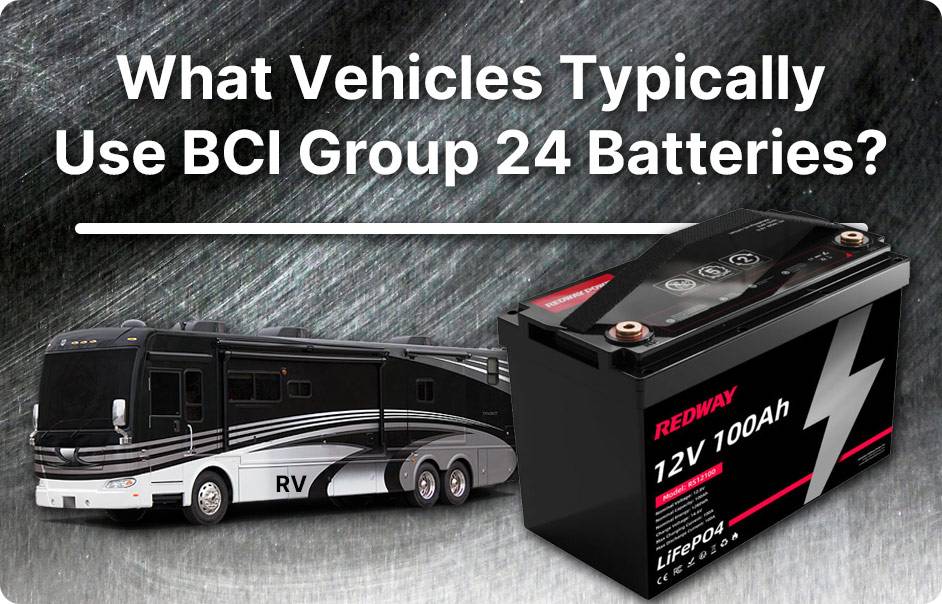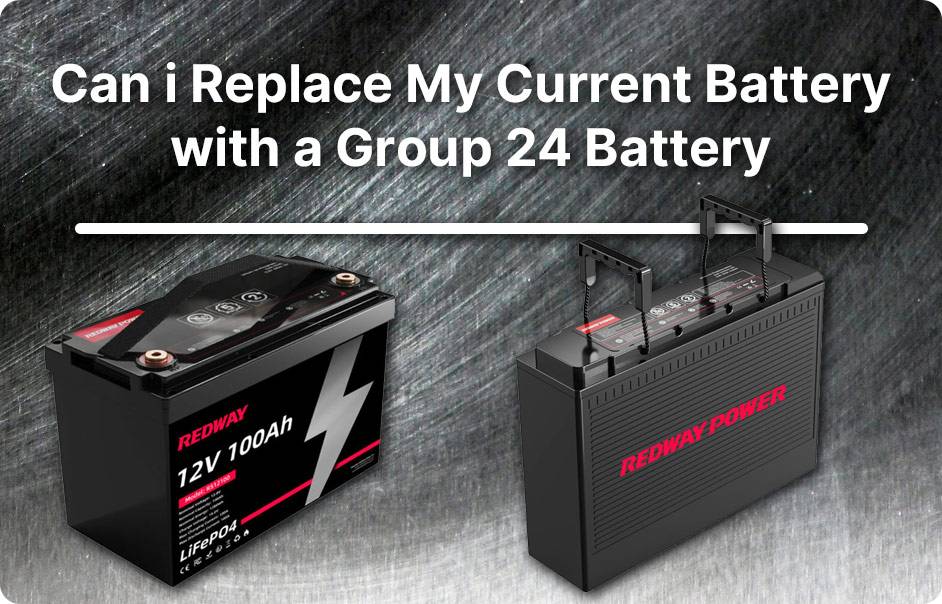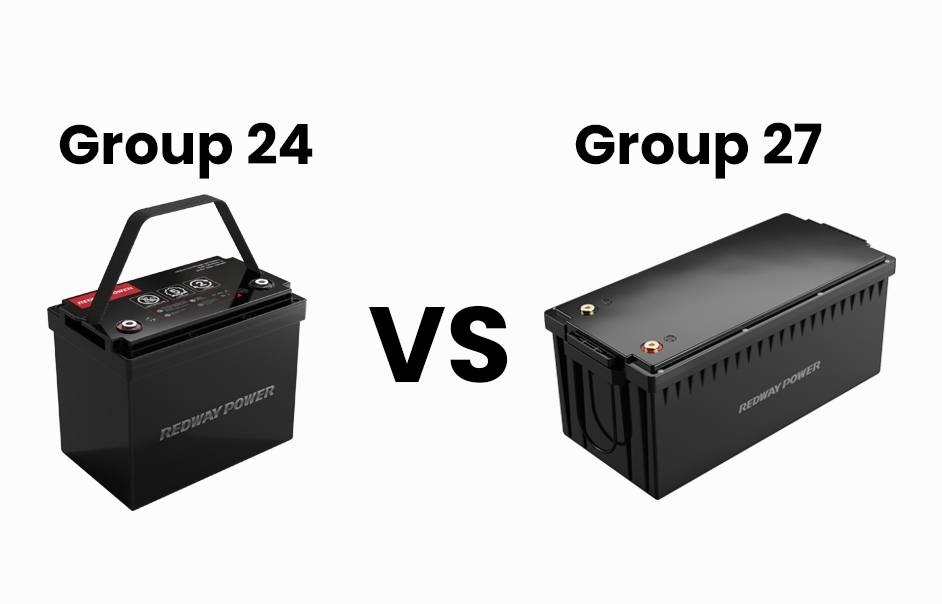BCI Group 24 batteries are versatile power sources commonly found in cars, trucks, RVs, boats, and marine applications. With standardized sizing and reliability, they provide essential electrical power for starting engines and running onboard systems.
What are BCI Group 24 Batteries?
BCI Group 24 batteries have physical dimensions of approximately 10.25 x 6.8125 x 8.875 inches (260 x 173 x 225 mm). However, within this group, there are various subgroups available.

| BCI Group Size | L (mm) | W (mm) | H (mm) | L (inch) | W (inch) | H (inch) | Redway Power LiFePO4 Battery |
| 24 | 260 | 173 | 225 | 10 1/4 | 6 13/16 | 8 7/8 | Group 24 Battery |
| 24F | 273 | 173 | 229 | 10 3/4 | 6 13/16 | 9 | Group 24F Battery |
| 24H | 260 | 173 | 238 | 10 1/4 | 6 13/16 | 9 3/8 | Group 24H Battery |
| 24R | 260 | 173 | 229 | 10 1/4 | 6 13/16 | 9 | Group 24R Battery |
| 24T | 260 | 173 | 248 | 10 1/4 | 6 13/16 | 9 3/4 | Group 24T Battery |
Please note: Amazon affiliate links in the chart open in new windows for your convenience.
The physical dimensions of Group 24 batteries closely resemble several other battery groups, allowing for versatile interchangeability. Here are the maximum dimensions (L x W x H) of some related groups:
- Group 78: 10.25 x 7.0625 x 7.6875 inches (26 x 17.9 x 19.6 cm)
- Group 34: 10.25 x 6.8125 x 7.875 inches (26 x 17.3 x 20 cm)
- Group 24: 10.25 x 6.8125 x 8.875 inches (26 x 17.3 x 22.5 cm)
Group 24 batteries are widely available at hardware and automotive stores, as well as online retailers. If you require a new Group 24 battery, it’s readily accessible.
What are advantages of BCI Group 24 batteries?
Choosing a BCI Group 24 battery offers several advantages:
- Versatility: BCI Group 24 batteries are versatile and can be used in a wide range of vehicles, including cars, trucks, RVs, boats, and marine applications. They are suitable for both starting and deep-cycle applications, making them a versatile option for various vehicles and systems.
- Standardized Size: Group 24 batteries have standardized dimensions, making them easy to install and replace. This standardization ensures compatibility with a wide range of vehicles and battery compartments.
- Available Options: BCI Group 24 batteries are available in different chemistries, including lead-acid, AGM (Absorbent Glass Mat), and lithium-ion. This allows you to choose the battery type that best suits your vehicle’s requirements and performance needs.
- Reliable Performance: Group 24 batteries offer reliable performance, with specifications such as nominal capacity (Ah), cold cranking amps (CCA), marine cranking amps (MCA), and reserve capacity (RC) meeting the demands of various applications. They provide sufficient power to start the engine, run electronic accessories, and power onboard systems reliably.
- Widely Available: BCI Group 24 batteries are widely available at automotive stores, online retailers, and battery distributors, making them easy to find and purchase when needed. This ensures convenience and accessibility for vehicle owners.
Overall, choosing a BCI Group 24 battery provides a reliable, versatile, and readily available power solution for your vehicle’s electrical needs.
What vehicles typically use BCI Group 24 batteries?
BCI Group 24 batteries are commonly used in various vehicles and applications, including:

- Cars: Some mid-size to larger cars, particularly those with higher electrical demands or optional accessories, may utilize Group 24 batteries to provide starting power and electrical energy.
- Light Trucks: Certain light trucks, including pickups and vans, may use Group 24 batteries to meet their starting and electrical power requirements.
- Marine and RVs: Group 24 batteries are often employed in marine vessels and recreational vehicles (RVs) to power onboard electronics, lights, and other accessories.
- Golf Carts: Electric golf carts frequently use Group 24 batteries to provide the necessary electrical power for propulsion and accessories.
- Industrial Equipment: Some light industrial equipment, such as forklifts and utility vehicles, may utilize Group 24 batteries for their electrical systems.
Overall, BCI Group 24 batteries are versatile and suitable for a range of applications, making them a popular choice for vehicles and equipment with moderate power demands.
Best Sellers of BCI Group 24 Batteries in 2024
Below is a chart featuring some of the most popular BCI Group 24 batteries:
| Model | Battery Type Chemistry |
Capacity(Ah) RC (min) |
CCA MCA |
Weight (lbs/kg) Review |
| ACDelco M24AGM | Deep Cycle AGM |
80 140 |
500 625 |
43.0 lbs; ~19.5 kg |
| Battle Born BB1250 | Deep Cycle LiFePO4 |
50 120 |
60A const. 100A 30s |
22 lbs; 9.96 kg |
| Battle Born BB1275 | Deep Cycle LiFePO4 |
75 180 |
100A const. 200A 30s |
27 lbs; 12.23 kg |
| Exide Edge FP-AGM24DP | Dual Purpose AGM |
75 145 |
775 930 |
50 lbs; ~22.7 kg |
| Lifeline GPL-24T | Deep Cycle AGM |
80 149 |
550 680 |
56 lbs; 25.5 kg |
| LiTime 12V 100Ah Mini | Deep Cycle LiFePO4 |
100 240 |
100A cont. 250A 5 sec |
19 lbs; 8.6 kg |
| Mighty Max ML75-12 | Deep Cycle AGM |
77 – |
– – |
50.71 lbs; ~22.97 kg |
| Mighty Max ML75-12 Gel | Deep Cycle Gel |
75 – |
– – |
50.55 lbs; 22.9 kg |
| NorthStar NSB-AGM24F | Dual Purpose AGM |
76 160 |
840 1000 |
57 lbs; ~25.8 kg |
| Power Sonic PS-12750 | Deep Cycle AGM |
78 – |
900A 5s | 50.6 lbs; 22.9 kg |
| UPG UB12750 | Deep Cycle AGM |
75 – |
– – |
49.1 lbs; ~22.3 kg |
| VMAXTANKS FLP24-1265 | Deep Cycle LiFePO4 |
65 ~150 |
65A const. 120A 3s. |
15.5 lbs, 7.0 kg |
| VMAXTANKS MB107-85 | Deep Cycle AGM |
85 170 |
– – |
55 lbs; ~24.9 kg |
| VMAXTANKS MR107-85 | Deep Cycle AGM |
85 160 |
– 700 |
55 lbs; ~24.9 kg |
| VMAXTANKS SLR-85 | Deep Cycle AGM |
85 180 |
– – |
55 lbs; ~24.9 kg |
| Weize FP12750/TL1275 | Deep Cycle AGM |
77 – |
– – |
46 lbs; 20.9 kg |
Please note: Amazon affiliate links in the ‘Model’ column open in new windows for the most up-to-date prices and offers.
BCI Group 24 batteries predominantly consist of deep-cycle and dual-purpose batteries commonly employed in vehicles equipped with dual battery systems.
Can I Use Group 34 Batteries to Replace Group 24 Batteries?
If you need a BCI Group 24 starting battery but can’t find one, consider choosing a Group 34 starting battery instead. Despite being smaller and lighter, Group 34 batteries are designed specifically for starting and cranking, offering higher current output compared to deep-cycle Group 24 batteries.
| Model | Battery Type Chemistry |
Capacity RC |
CCA MCA |
Weight (lbs/kg) Review |
| ACDelco 34AGM | Starting AGM |
60 115 |
740 – |
38.7 lbs; 17.4 kg – |
| Banshee 34M | Dual Purpose Flooded |
66 100 |
750 870 |
37.0 lbs; 16.8 kg – |
| Banshee LFP-34M | Dual Purpose LiFePO4 |
50 ~120 |
800 – |
13.8 lbs; 6.25 kg – |
| Deka 9A34 | Dual Purpose AGM |
55 120 |
750 955 |
41 lbs; 18.6 kg – |
| Delphi BU9034 | Starting AGM |
55 120 |
775 – |
42.5 lbs; 19.3 kg – |
| DieHard 38232 | Starting AGM |
55 120 |
775 – |
44.5 lbs; 20.2 kg |
| Exide Edge FP-AGM34 | Dual Purpose AGM |
60 120 |
770 – |
45.9 lbs; 20.8 kg – |
| Interstate MTZ-34 | Starting AGM |
63 125 |
800 1000 |
47 lbs; 21.3 kg – |
| Interstate MTZ-34R | Starting AGM |
63 125 |
800 1000 |
47 lbs; 21.3 kg – |
| Mighty Max ML-GROUP34 | Deep Cycle AGM |
60 – |
– | 39.7 lbs; 18 kg – |
| NorthStar NSB-AGM34 | Dual Purpose AGM |
65 134 |
880 1050 |
51 lbs; 23.1 kg – |
| NorthStar NSB-AGM34/78 | Dual Purpose AGM |
65 134 |
880 1050 |
51 lbs; 23.1 kg – |
| Odyssey 34-PC1500T | Dual Purpose AGM |
68 135 |
850 1050 |
49.5 lbs; 22.4 kg |
| Optima RedTop 34 | Starting AGM |
50 100 |
800 1000 |
37.9 lbs; 17.2 kg |
| Optima 8016-103 D34M | Dual Purpose AGM |
55 120 |
750 870 |
43.5 lbs; 19.7 kg |
| VMAXTANKS XTR34-75 | Deep Cycle AGM |
75 145 |
– 825* |
45.0 lbs; 20.4 kg |
| Weize 34M Dual Purpose | Dual Purpose AGM |
55 120 |
650 780 |
42.6 lbs; 19.3 kg – |
| XS Power D3400 12V 65 Ah | Dual Purpose AGM |
65 135 |
– 1000 |
47.0 lbs; 21.32 kg |
| XS Power D3400 12V 80Ah | Dual Purpose AGM |
80 160 |
– 1150 |
50 lbs; 22.67 kg |
Please note: Amazon affiliate links in the ‘Model’ column open in new windows for the most up-to-date prices and offers.
BCI Group 24 batteries typically offer a nominal capacity of 75-85 Ah, 500-840 CCA, 625-1000 MCA, and RC values between 140 and 180 minutes.
In contrast, BCI Group 34 batteries have a nominal capacity ranging from 50 to 80 Ah, 740 to 880 CCA, 825 to 1150 MCA, and RC values between 100 and 160 minutes.
It’s important to highlight that although the VMAXTANKS XTR34-75 is considered a deep cycle battery, it boasts an impressive 1100 HCA (Hot Cranking Amps). The MCA value of 825 Amps is calculated using the formula:
This approximation demonstrates the battery’s robustness and strength.
While it’s technically possible to use a Group 34 battery as a replacement for a Group 24 battery, there are some factors to consider:
- Size and Fitment: Group 34 batteries are typically smaller in size compared to Group 24 batteries. Ensure that the Group 34 battery fits properly in the battery compartment of your vehicle without any modifications.
- Performance: Group 34 batteries may have different specifications, including capacity, CCA (Cold Cranking Amps), and RC (Reserve Capacity), compared to Group 24 batteries. Ensure that the replacement battery meets or exceeds the requirements of your vehicle for reliable performance.
- Intended Use: Group 24 batteries are commonly used in both starting and deep-cycle applications. If your vehicle requires a deep-cycle battery, ensure that the Group 34 battery you choose is suitable for this purpose.
- Consultation: It’s always recommended to consult your vehicle’s manual or a professional technician before substituting one battery size for another. They can provide guidance on compatibility and ensure that the replacement battery meets the specific requirements of your vehicle.
In summary, while Group 34 batteries can be used as replacements for Group 24 batteries, careful consideration of size, performance, and intended use is essential to ensure compatibility and reliable operation in your vehicle.
FAQs
What vehicles commonly use Group 24 batteries?
Group 24 batteries are commonly used in various vehicles such as mid-size to larger cars, light trucks, marine vessels, RVs, golf carts, and some light industrial equipment.
What are the dimensions of a Group 24 battery?
Group 24 batteries typically have dimensions of approximately 10.25 inches in length, 6.75 inches in width, and 9.75 inches in height.

What is the capacity of a Group 24 battery?
The capacity of Group 24 batteries varies depending on the specific model and manufacturer. However, they generally range from around 70 Ah to 100 Ah.
Are Group 24 batteries suitable for deep cycle applications?
While Group 24 batteries are primarily designed for starting and general electrical power applications, some models may offer dual-purpose capabilities suitable for both starting and deep cycle use. It’s essential to check the specifications provided by the manufacturer.
How long do Group 24 batteries typically last?
The lifespan of a Group 24 battery depends on various factors, including usage patterns, maintenance, and environmental conditions. On average, these batteries can last anywhere from three to five years under normal operating conditions.
Can I replace my current battery with a Group 24 battery if my vehicle originally had a different battery size?
It’s essential to ensure that a Group 24 battery fits within your vehicle’s battery compartment and meets its electrical requirements. While some vehicles may accommodate different battery sizes, it’s best to consult your manual or a professional to verify compatibility before making a replacement.










